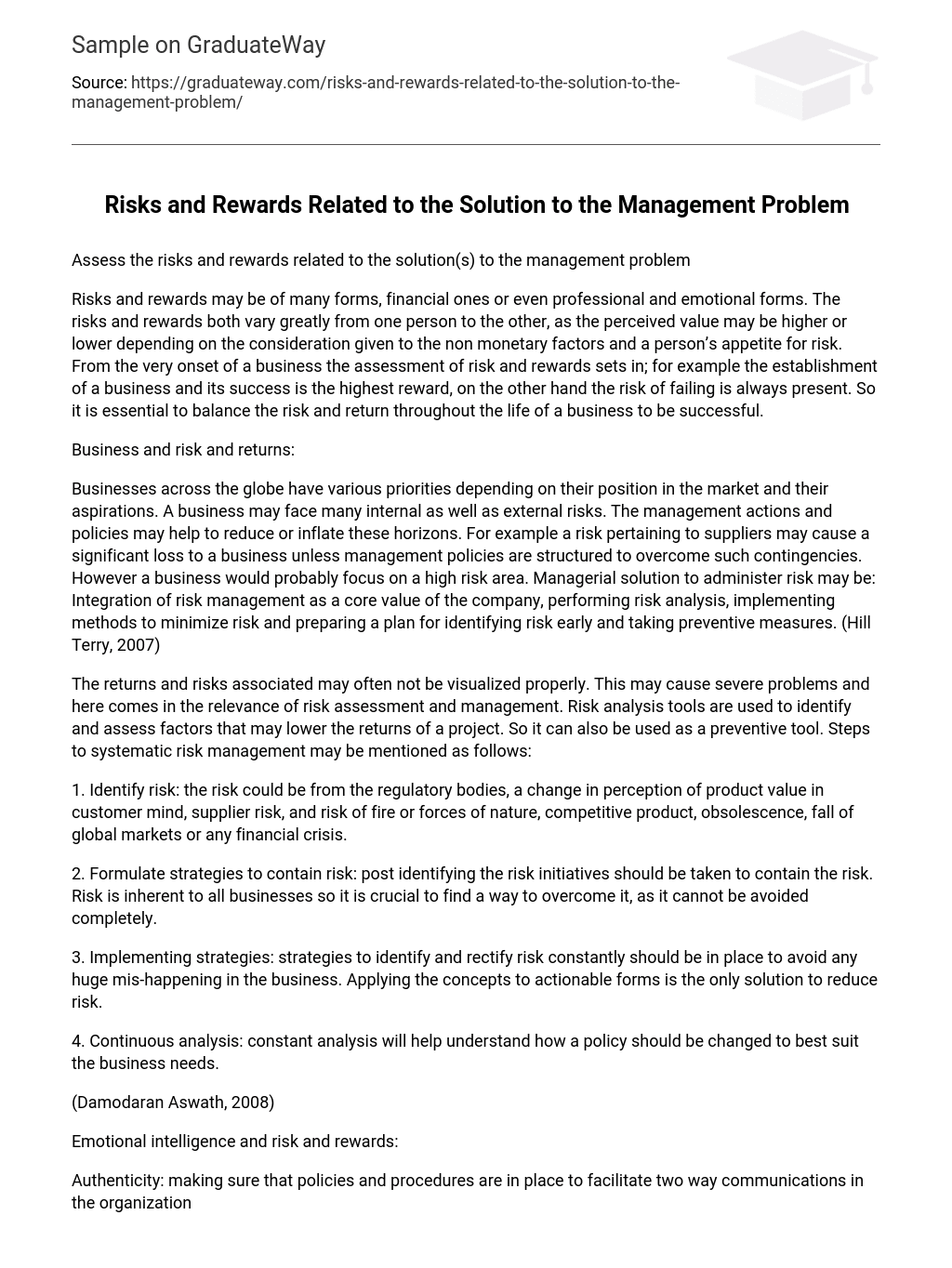Assess the risks and rewards related to the solution(s) to the management problem
Risks and rewards may be of many forms, financial ones or even professional and emotional forms. The risks and rewards both vary greatly from one person to the other, as the perceived value may be higher or lower depending on the consideration given to the non monetary factors and a person’s appetite for risk. From the very onset of a business the assessment of risk and rewards sets in; for example the establishment of a business and its success is the highest reward, on the other hand the risk of failing is always present. So it is essential to balance the risk and return throughout the life of a business to be successful.
Business and risk and returns:
Businesses across the globe have various priorities depending on their position in the market and their aspirations. A business may face many internal as well as external risks. The management actions and policies may help to reduce or inflate these horizons. For example a risk pertaining to suppliers may cause a significant loss to a business unless management policies are structured to overcome such contingencies. However a business would probably focus on a high risk area. Managerial solution to administer risk may be: Integration of risk management as a core value of the company, performing risk analysis, implementing methods to minimize risk and preparing a plan for identifying risk early and taking preventive measures. (Hill Terry, 2007)
The returns and risks associated may often not be visualized properly. This may cause severe problems and here comes in the relevance of risk assessment and management. Risk analysis tools are used to identify and assess factors that may lower the returns of a project. So it can also be used as a preventive tool. Steps to systematic risk management may be mentioned as follows:
1. Identify risk: the risk could be from the regulatory bodies, a change in perception of product value in customer mind, supplier risk, and risk of fire or forces of nature, competitive product, obsolescence, fall of global markets or any financial crisis.
2. Formulate strategies to contain risk: post identifying the risk initiatives should be taken to contain the risk. Risk is inherent to all businesses so it is crucial to find a way to overcome it, as it cannot be avoided completely.
3. Implementing strategies: strategies to identify and rectify risk constantly should be in place to avoid any huge mis-happening in the business. Applying the concepts to actionable forms is the only solution to reduce risk.
4. Continuous analysis: constant analysis will help understand how a policy should be changed to best suit the business needs.
(Damodaran Aswath, 2008)
Emotional intelligence and risk and rewards:
Authenticity: making sure that policies and procedures are in place to facilitate two way communications in the organization, avoid bias and quick resolution of problems, may help deter problems related to the staff. (Gallipeau, Dan R., 2001).
Ethics: being ethical and morale in the daily operations of the business helps organizations to combat risk of any regulatory reforms which arise from unethical conduct. It also will set in a feeling of being a just organization in the minds of the employees.
Respect: the employees, suppliers and all internal and external stockholders should be treated with respect to avoid any uncalled situation.
Stress management: the employees would are trained to face the stress and perform consistently, can stand as a mentor for others in the organization.
Therefore emotional intelligence can help the organization better manage their employees and avoid any risk of high turnover of staff or any lawsuits from the employees end. It has been seen that managers with high interpersonal skills perform help reduce people related problems and risks. Also if the employees are happy then they are motivated to perform better. So higher productivity is an intrinsic reward attached to the concept. Entrepreneurs and risk and rewards: J.B Say coined the term “entrepreneur” in 1800s, as a person who utilizes change to explore various business opportunities. Some of the rewards attached to becoming an entrepreneur are:
· Financial rewards: a well sought business idea and plan may reap good returns and wealth for the entrepreneur.
· Social rewards: the creation of jobs and providing financial stability for other members of the society is a social rewards attached.
· Independence: the independence from supervision, large corporation bureaucracy, high potential for growth and overall feeling of independence are part of the rewards on offer. (Longenecker Justin etc, 2010)
While the risks attached may be:
· Financial risk: since the financial investments are personal so the liabilities and the substantial loss possible are high.
· Social risk: friends and family may find less time with a person running his own business, especially in the initial years.
· Psychological risk: stress, time management, financial management and overall functioning of a business has to be managed by entrepreneur. So there is a lot of pressure on the person, so he may feel emotional distress.
There are many benefits or problems attached to entrepreneurship but it is essential to have a risk return analysis of a project to understand the feasibility of the business product or service before venturing into a business. (Roberts Michael, 2003)
Reference:
Damodaran Aswath, 2008, Strategic risk taking: a framework for risk management, Wharton School Publishing, New Jersey
Roberts Michael, 2003, Managing risk and reward in the entrepreneurial venture
Hill Terry, 2007, how do you measure the risk and rewards that are associated with your business?
Charette Robert, August 1999, IT Pro, The competitive edge of risk entrepreneurs
Longenecker Justin, William Petty, Leslie Palich, Carlos Moore, 2010, Small business management: launching and growing entrepreneurial ventures, South Western, USA
Gallipeau, Dan R., Jurors’ Views of Sexual Harassment, New York Employment Law Practice, 2001
http://www.gsb.stanford.edu/community/bmag/sbsm624/sbsm62402a.htm
http://www.managerwise.com/article.phtml?id=405
http://www.managerwise.com/article.phtml?id=136
http://www.managerwise.com/article.phtml?id=1
http://ezinearticles.com/?Your-Own-Business—Risks-Vs-Rewards&id=1464351
http://blogs.ft.com/gapperblog/2010/01/the-risks-and-rewards-of-sharing-information-online/
http://www.notesondesign.net/resources/design-careers/starting-a-business-risks-and-rewards/
http://findarticles.com/p/articles/mi_m0FOX/is_1998_Nov_4/ai_53165907/





